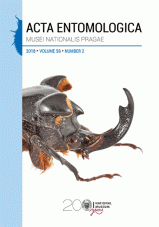The last instar larva and pupa of Ora depressa (Coleoptera: Scirtidae), a marsh beetle with underwater pupation
Libonatti Maria L., Jorge Gabrielle, Archangelsky Miguel, Michat Mariano C.
Acta Entomologica Musei Nationalis Pragae 58(2): 441-455, 2018
Published online: 24th October 2018
Published in print: 31st December 2018
Views: 1434
Abstract: In this contribution we describe and illustrate for the first time, detailed
morphology and chaetotaxy of the last instar larva and the pupa of Ora depressa
(Fabricius, 1801), and provide diagnostic characters and information on its
biology. The last instar larva of O. depressa exhibits the characters
traditionally recognized as diagnostic of the genus, i.e. the tip of the
mandible obtuse, and the fourth maxillary palpomere long, almost as long as
third palpomere. Ora depressa is characterized by a broadly elliptical body,
which is widest at the metanotum, being brownish testaceous in color with
several brown spots, having the dorsal surface mostly covered with numerous
grooved scale-like setae and also several ungrooved scale-like setae, hair-like
setae, club-like setae and pore-like sensilla distributed in a specific pattern,
and the femur and tibiotarsus bearing a row of natatorial setae. The last instar
larva of Ora depressa can be distinguished from those of the other known species
of the genus by lobes of clypeolabrum being as long as wide and socket bristles
with 2–6 inner teeth. The pupa of O. depressa differs from those of the other
known species of the genus in the absence of pronotal horns and by the place
where pupation occurs. Ora depressa pupates underwater, hanging from
water’s surface with the aid of the laterally expanded pronotum which bears
hydrophobic setation along the lateral margins.
Key words: Coleoptera, Scirtidae, marsh beetles, larva, pupa, morphology, chaetotaxy, Neotropical Region
Papers
Taxonomic revision of the genus Glenopopillia (Coleoptera: Scarabaeidae: Rutelinae)Cuccodorodes gen. nov., an apterous Batrisitae from the tropical Himalayas (Coleoptera: Staphylinidae: Pselaphinae)Taxonomic review of the genus Calyptopsis of Turkey and adjacent areas (Coleoptera: Tenebrionidae: Tentyriini)Taxonomic notes on the genus Hydrobaenus with description of H. simferopolus sp. nov. from Crimea (Diptera: Chironomidae)Review of the plant bug genus Prolygus and related mirine taxa from eastern Asia (Hemiptera: Heteroptera: Miridae)Catalogue of the Incini with the description of the first Archedinus species from Honduras (Coleoptera: Scarabaeidae: Cetoniinae)Synapsis puluongensis sp. nov. and redescription of S. horaki (Coleoptera: Scarabaeidae), with a key to Vietnamese speciesRevision of the subgenus Nessus of the genus Hypocaccus from Central Europe, with description of a new species (Coleoptera: Histeridae)The last instar larva and pupa of Ora depressa (Coleoptera: Scirtidae), a marsh beetle with underwater pupationEleven new species and a new country record of Pselaphodes (Coleoptera: Staphylinidae: Pselaphinae) from China, with a revised checklist of world speciesTaxonomic review of Chin-wen Chen’s species described in the genus Smicromyrme (Hymenoptera: Mutillidae)A new species of genus Oxytauchira from India (Orthoptera: Acrididae)Larval chaetotaxy and morphometry of Oosternum costatum (Coleoptera: Hydrophilidae) including a discussion of larval characters with phylogenetic relevanceSelasia dembickyi sp. nov., the first member of Drilini (Coleoptera: Elateridae) from South East Asia, with the description of S. jenisi sp. nov. from NepalDescription of a new species of Rhizococcus (Hemiptera: Coccomorpha: Acanthococcidae) from IranThe Unicorn exists! A remarkable new genus and species of Perilissini (Hymenoptera: Ichneumonidae) from South East AsiaNew minute Drilini species significantly extend the distributions of Lolosia and Microselasia (Coleoptera: Elateridae: Agrypninae) in tropical AfricaA new species of the genus Nenasa (Hemiptera: Fulgoroidea: Caliscelidae) from mainland ChinaA new species and two new synonyms of Mongolian Nemotelus (Diptera: Stratiomyidae)A new species of the genus Paratrichius from northern Vietnam (Coleoptera: Scarabaeidae: Cetoniinae)Two species previously placed in Euconnus s. str. belong in the endemic Madagascan subgenus Glabriconnus (Coleoptera: Staphylinidae: Scydmaeninae)Gibbocicada brasiliana, new genus and new species from Brazil and a key for the genera of Tibicinini (Hemiptera: Auchenorrhyncha: Cicadidae)Two new species of Glischrochilus with taxonomic comments, new records from Asia, and a world checklist of the genus (Coleoptera: Nitidulidae)New species of bristletails of the genus Lepismachilis (Archaeognatha: Machilidae) from Serbia and MontenegroSix new species of Dolichopeza (Nesopeza) from China (Diptera: Tipulidae)Is repeated cypermethrin fumigation dangerous for the mitochondrial DNA in dry insect samples? 